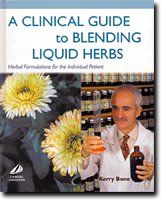
All Local Guides
Alabama Alaska Arizona Arkansas California Colorado Connecticut DC Delaware Florida Georgia Hawaii Idaho Illinois Indiana Iowa Kansas Kentucky Louisiana Maine Maryland Massachusetts Michigan Minnesota Mississippi Missouri Montana Nebraska Nevada New Hampshire New Jersey New Mexico New York North Carolina North Dakota Ohio Oklahoma Oregon Pennsylvania Rhode Island South Carolina South Dakota Tennessee Texas Utah Vermont Virginia Washington West Virginia Wisconsin Wyoming |
 |
A Clinical Guide to Blending Liquid Herbs: Herbal Formulations for the Individual Patient
Book Review by Jonice Owen, DC, FACO, Chom
Page four, in the "strength or ratio" section, answered questions I've had about the strength of an herbal liquid preparation: "It is usually expressed as a ratio. For example 1:2 means that 2 ml of the final preparation is equivalent to 1 g of the dried herb from which the preparation was made. When fresh herbs are used, the ratio can be based on the fresh weight, in which case, this information should be additionally specified. Herbal liquid preparations weaker than 1:2 are usually called tinctures, whereas 1:1 and 1:2 preparations are called extracts. ...These days, 1:1 liquid extracts are often made by reconstituting soft or powdered concentrates and as a result can be of inferior quality." This format informs and encourages practitioners to formulate their own tinctures, or at least be aware of what they might be getting and dispensing to clients and/or patients. The "monographs" section outlines 125 plants and 137 liquid herbal extracts, from A (albizia) to Y (yellow dock), with aloe vera, arnica, calendula, chamomile, ginko, ginger, lavender, oats, olive leaf, rosemary, saw palmetto, St. John's wort and wild yam, to name a few well-known herbs; ashwaganda, Jamaica dogwood, schisandra, spiny jujube, tylophora, and white peony are a few less commonly known. The individual monographs are user-friendly, disseminating information in an orderly, clear format - particularly useful if you're searching for quick answers. You will come to know the botanical names of the common plants, the family names and the plant part used. The individual monographs are user-friendly, disseminating information in an orderly, clear format - particularly useful if you're searching for quick answers. You will come to know the botanical names of the common plants, the family names and the plant part used. Information on dispensing follows, with discussion of actions, potential indications, contraindications, warnings and precautions, interactions, use in pregnancy and lactation, side-effects and dosages. Mr. Kerry delivers pertinent facts from his own clinical practice and research in the supporting information portion of the text, including traditional prescribing information, pharmacologic research, and clinical studies, which he references at the end of each monograph. This book is valuable to empirical or intuitive practitioners, as well as for modern, Western-trained prescribers adept at reading peer-reviewed literature to support inclusion of traditionally-used herbs in their own practice. The appendices include specific dosage information for the 125 herbs outlined, a glossary of herb actions, such as astringents, diaphoretics, and progesterogenics, with clear, one-sentence descriptions, followed by a list by actions. There is also a glossary of clinical trial terms. A Clinical Guide to Blending Liquid Herbs successfully bridges the gap between standard herbal texts you have on your desks, such as narrative, down-home herbal texts that your patients rely on; and a literature search of peer-reviewed journals, which is the wave of the future of herbalism regaining an interface with traditional Western medicine. Patients often ask me for herbal recommendations or about herbs they are considering using. In my efforts to offer well-founded, up-to-date information anchored in traditional Western herbal prescribing, this text has it all. It maintains a traditional approach while leading natural health practices into the future of alternative medicine.
|
|
|||||||||
All Rights Reserved, Nutritional Wellness, 2012.
Date Last Modified - Wednesday, 24-Nov-2010 14:27:50 PDT

 This finely presented text tells it all. It guides the user to new, updated information, lends deeper understanding to the seasoned herbalist, and steers the curious to greater comprehension. This text has something for everyone. Author Kerry Bone explains to us that very few modern texts reflect the core of material required by the modern Western herbalist. Therefore, he sets forth information about individual herbs and makes recommendations for combination or formulated liquid herbal remedies. The author begins with information about the plant extraction process, as well as dosages of herbal extracts, and continues on to suggest formulations for specific complaints.
This finely presented text tells it all. It guides the user to new, updated information, lends deeper understanding to the seasoned herbalist, and steers the curious to greater comprehension. This text has something for everyone. Author Kerry Bone explains to us that very few modern texts reflect the core of material required by the modern Western herbalist. Therefore, he sets forth information about individual herbs and makes recommendations for combination or formulated liquid herbal remedies. The author begins with information about the plant extraction process, as well as dosages of herbal extracts, and continues on to suggest formulations for specific complaints.
 10 out
of 10
10 out
of 10
